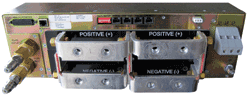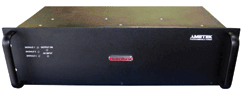Power supply needs for MOCVD in high brightness LED production
To accelerate HBLED market expansion, manufacturers need metal-organic-chemical-vapor-deposition (MOCVD) equipment
BY WILLIAM RUFF
Ametek Programmable Power
San Diego, CA
www.programmablepower.com
The semiconductor industry can look forward to continued rapid growth in LED demand as consumers seek more energy-efficient lighting solutions. This is partially spurred by government actions that discourage continued use of incandescent lamps. Of the alternative lamp technologies metal halide arc-discharge, fluorescent, and LED the most energy-efficient per lumen of output is LED.
High-brightness light-emitting diodes (HBLEDs) are rapidly becoming the incandescent replacement technology of choice due to higher efficacy (light output per input watt), long lifetimes, and the ability to control chromaticity. From an ecological perspective, LEDs do not use mercury, unlike metal halide and fluorescent lamps. Looking forward, ongoing R&D and production scaling efforts hold the promise of continued energy-efficiency improvements, while unit costs and, ultimately, retail prices are driven down.
Challenges
Price, cost, and the resultant margins are continuing challenges for HBLED device makers. The rapid expansion of manufacturing capacity over the last few years, coupled with demand saturation in the LCD backlighting market, has resulted in low tool-utilization rates and downward pressure on the average selling price (ASP) of HBLEDs.
The good news is that the price points are approaching levels favoring more rapid adoption of the technology for general lighting applications. The bad news is that the downward pressure on ASP and shrinking margins are driving supplier consolidation, as well as putting tremendous pressure on the equipment and consumables supply base to further drive down the costs of tools, substrates and other items.
Industry response
Volume manufacturing of HBLEDs uses a metal-organic-chemical-vapor-deposition (MOCVD) process. The devices are currently built on sapphire or silicon carbide substrates, although there are recent reports of new processes that rely on use of silicon substrates.
To create the light-producing structure requires precise deposition on these substrates of 50 to 60 epitaxial films of varying thicknesses and doping concentrations. The layers are deposited sequentially in a reactor in a process that can take five or more hours per reactor batch.
From a manufacturing perspective, cost-reduction efforts are generally focused on three areas:
1. Increased reactor processing capacity and throughput
2. Increased footprint efficiency
3. Increased yield of good devices
Increased reactor processing capacity and throughput
Currently, up to 6-in.-diameter wafers are the most commonly used types, with a trend toward larger substrate sizes. This is accomplished with larger deposition reactors capable of processing more and larger wafers, and multi-reactor configurations served by central handlers. The latter maintains substrates under a vacuum as they are moved between process reactors, thereby reducing time lost to vacuum pump-down, while also reducing the potential for contamination.
In general, MOCVD is a thermal process. Substrates are heated to a high temperature (up to 1,200C), and various metal organic precursors are introduced into the reactor vessel to form the complex thin films that make up the device. Precise temperature control and uniformity (typically
Depending on the particular machine design, process heat is supplied by lamps, resistance or induction sources. The precise control and ramping of power supplies driving these sources are critical and a major challenge for suppliers of this equipment.
New reactor designs require many 10’s of kilowatts to deal with long thermal time constant. They often employ sophisticated model-based control algorithms to close the loop with heater power supplies in order to maintain the required uniformity and ramp control.
To ensure the consistency of these model-based process controls, the latest power supply designs use inner and outer control loops implemented with high-speed ADCs/DACs and DSPs driving fast-switching MOSFET power sections. The precision and consistency of the power supply, as part of the overall process control system, provides important enabling technology in the industry’s efforts to improve capacity, throughput and yields.
Just as important, these power supplies must have the ability to digitally monitor and report on dozens of critical internal parameters indicating the state of health of the power supply, as well as the impedance and characteristics of the loads being driven. This requires supplies with advanced designs that can provide valuable real-time insight to equipment operators of overall system readiness. In addition, they must be high-reliability power sources that reduce unplanned down-time and designed for less time intensive preventive maintenance protocols.
Increased footprint efficiency
With respect to increasing the footprint efficiency of the machines, the latest power supply designs use water cooling and efficient packaging to double the power density, resulting in fewer power cabinets and less clean-room floor space. For example, moving from air to water cooling, coupled with advanced power conversion designs, has enabled the packaging of 30-kW supplies in 3U (5.25-in. height) of rack space. This is double the power density previously available with air-cooled programmable supplies.
Beyond higher power density, these new power source designs incorporate multiple independently programmable sections with separate outputs. This flexibility enhances footprint efficiency, as different heating zones may require different voltages and power levels. Being able to dedicate power sections from one rack to different zones consumes far less cabinet space. This also permits seamless redundancy as a spare power section can be combined into the output in real time if needed.
Yield enhancement
Yields for LEDs depend on the end-use application and how stringent the requirements are for that application. Yields for simpler LEDs (indicators etc.) fall into the high 90% range. It is estimated that yields for HBLEDs destined for flat-panel-display (FPD) backlighting applications range from 60% up to 90% at the top-tier manufacturers. However, for general lighting applications, the yields are lower, estimated to range up to 60% at the top tier producers.


Fig. 1: The latest generation of programmable power sources for MOCVD equipment has a smaller footprint and is designed for integration with computerized control to help reduce process costs and improve yields in HBLED manufacturing.
As noted previously, temperature control and uniformity are key parameters affecting yields from batch to batch and within a batch. Recognizing the important role the programmable power supply has with respect to driving the process heat source, and hence the yields, real-time digital control is critical. This was recognized early in the design of next-generation programmable power supplies for MOCVD applications. These power sources facilitate real-time control via Graphical User Interfaces (GUIs) that enable the user to tap into an array of functions for monitoring the process (see Fig. 1 ).
Advanced features can include a built-in oscilloscope function that allows the user to view various parameters as a function of time. These include the obvious, such as output voltage, current, and delivered energy, but also derivative data such as output impedance, output cable voltage drop, and output cable impedance. These provide valuable diagnostic insight into the health of the entire system. This is especially critical for long-duration processes typical in HBLED production.
Additional features can include a “flight data recorder” capability. This gives the user the ability to access multiple continuously recorded parameters such as those mentioned above, plus others that include ac input power quality (sags, drops, spikes, etc.) to help diagnose issues leading to unexpected process results and reduced yields. An advanced digital architecture also facilitates the equipment designer’s need to support a variety of field bus implementations. ■
Advertisement
Learn more about AMETEK Programmable Power





